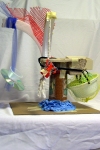One of my kids is a father. Jarell is 18, and has a one year old son. Jarell’s also a DCF kid. He lives in a group home and gets money from DCF. They will help him out until he’s 21…as long as he stays in school and lives up to his end of the deal: no trouble with the law, get passing grades in school, go to school, etc. etc. At first, these sound like simple requests…but some of these things are harder for Jarell than you might think. Most of the kids at my school can walk there, no problem. If they miss the bus, no big deal, school is a ten minute walk away. But Jarell, because he lives in a group home, lives in the next town over. And on the other side of it. That was the only placement they could give him. So the school tells him they can’t provide him transportation, so he’ll need to take the city bus. Both ways. And pay for it. That went on for a few months until someone finally questioned why his attendance was so poor. Could his commute possibly be the reason? Now a van goes and picks him up. But it’s too late for his grades, because he’s already missed too much class to make up the work. Was it his fault? When DCF comes and looks at his grades and attendance and tells him that he’s not holding up his end of the deal, is it wrong of him to get upset and walk out? I don’t know about you, but when I was 18, I had friends whose parents bought them nice little cars to drive around as they pleased. And those friends came and picked me up for school in the morning and dropped me off at the end of the day. And if they couldn’t, the worst case scenario was that I might have to take the school bus. Until I graduated and went off to the college that I was already accepted to that my parents were going to pay for, no worries. Kind of a different world, right?
So on the days that this kid makes it to school, he comes and sees me. There’s no time in his schedule for an art class, he’s got enough academic classes that he needs to squeeze in. But on occasion my classes will be doing a project that he loves, and he asks if he can make one too. Then, if he’s in a class and finishes his work for the day, he asks to come down to the art room to work on his project. The last, and most memorable one that he completed was a 3-D sculpture project. The assignment was to turn someone’s initials into a 3-D tribute. So Jarell chose his son. For the past three months, Jarell has worked diligently (well, as diligently as possible given the circumstances) on a project that would normally take a week or two. It is the most successful example of the project that I’ve seen…it’s better than the example I made to show the class. I never would have thought that this kid, with everything else going on in his life, would think that my little 3-D project was so important. In fact, I don’t think I’ve ever seen him stick with anything for so long in the three years that I’ve known him. But I know that every time I assign this project again, I’ll always be thinking of Jarell: up to his elbows in paper mache and masking tape, wanting to honor his son in any way he can. And I got to be a part of that.
Get the full lesson plan here!
Get the Rubric here!









